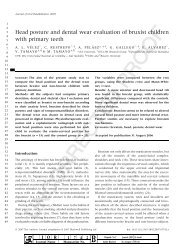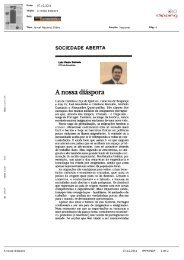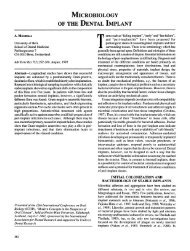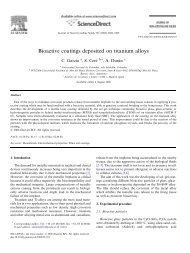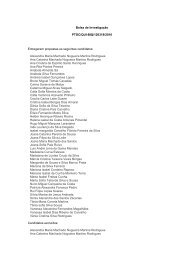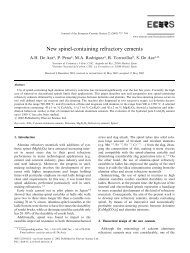Neutron diffraction residual stress analysis of ... - ResearchGate
Neutron diffraction residual stress analysis of ... - ResearchGate
Neutron diffraction residual stress analysis of ... - ResearchGate
You also want an ePaper? Increase the reach of your titles
YUMPU automatically turns print PDFs into web optimized ePapers that Google loves.
Available online at www.sciencedirect.com<br />
Journal <strong>of</strong> the European Ceramic Society 28 (2008) 1809–1814<br />
<strong>Neutron</strong> <strong>diffraction</strong> <strong>residual</strong> <strong>stress</strong> <strong>analysis</strong> <strong>of</strong><br />
zirconia toughened alumina (ZTA) composites<br />
J.F. Bartolomé a , G. Bruno b,∗ , A.H. DeAza c<br />
a Instituto de Ciencia de Materiales de Madrid, Consejo Superior de Investigaciones Científicas (CSIC),<br />
C/ Sor Juana Inés de la Cruz, 3, 28049 Madrid, Spain<br />
b School <strong>of</strong> Materials, Manchester Materials Science Centre, Grosvenor Street, Manchester, M1 7HS, UK<br />
c Instituto de Ceramica y Vidrio, CSIC, C/ Kelsen 5, 28049 Madrid, Spain<br />
Received 30 June 2007; received in revised form 17 December 2007; accepted 20 December 2007<br />
Available online 11 March 2008<br />
Abstract<br />
Measurements <strong>of</strong> the <strong>residual</strong> <strong>stress</strong>es in zirconia toughened alumina (ZTA) composites, containing 1.7, 14 and 22 vol% yttria-stabilized zirconia<br />
(3Y–TZP) were obtained by neutron <strong>diffraction</strong>. Over the range <strong>of</strong> volume fraction investigated, the hydrostatic <strong>stress</strong> in alumina and zirconia<br />
phases varies roughly linearly with the zirconia content. It is shown that these features can be qualitatively understood by taking into consideration<br />
the thermal expansion mismatch between the ZrO 2 and Al 2 O 3 grains. In addition, a decrease <strong>of</strong> the Al 2 O 3 line broadening is observed, which<br />
implies a decreasing micro-<strong>residual</strong> strain due to the ZrO 2 particles in the alumina. It is inferred that the <strong>residual</strong> strain field is highly hydrostatic,<br />
and that a decrease <strong>of</strong> the grain boundary shear <strong>stress</strong> occurs as a function <strong>of</strong> the reinforcement volume fraction. This phenomenon is more important<br />
in the case <strong>of</strong> 1.7 vol% zirconia composite because the zirconia particles are in the nanometre size range, with a narrow distribution.<br />
© 2008 Elsevier Ltd. All rights reserved.<br />
Keywords: Ceramic-matrix composites (CMCs); Zirconia Toughened Alumina (ZTA); Residual <strong>stress</strong>; <strong>Neutron</strong> <strong>diffraction</strong><br />
1. Introduction<br />
Internal <strong>stress</strong>es in discontinuously reinforced ceramic–<br />
ceramic composites mainly arise on cooling from fabrication<br />
temperature, owing to the thermo-elastic mismatch between<br />
their constituents. 1 Substantial strains may be generated in<br />
alumina matrix ceramics by including zirconia second-phase<br />
particles, the material being known as zirconia toughened alumina<br />
(ZTA). The linear thermal expansion coefficient (CTE) <strong>of</strong><br />
the alumina matrix is α Al2 O 3<br />
= 8 × 10 −6 ◦ C while that <strong>of</strong> the<br />
zirconia particles is α ZrO2 = 12 × 10 −6 ◦ C. When this composite<br />
is cooled from the sintering temperature, the reinforcement<br />
contracts more than the matrix. This results in tensile <strong>stress</strong><br />
in the particles and compressive <strong>stress</strong> in the matrix. Since<br />
the reinforcement particles have a nearly spherical form, the<br />
mean field <strong>stress</strong> is generally hydrostatic. However, simula-<br />
∗ Corresponding author. Present address: Corning SAS, CETC, BP3- F-77210<br />
Avon, France. Fax: +33 164 697454.<br />
E-mail address: brunog@corning.com (G. Bruno).<br />
tion works 2,3 have shown that the <strong>residual</strong> <strong>stress</strong> field can be<br />
highly anisotropic, and compressive tangential <strong>stress</strong> can coexist<br />
with tensile radial <strong>stress</strong> at the interface between matrix<br />
and reinforcement.<br />
Chevalier et al. 4 investigated the <strong>residual</strong> internal thermal<br />
<strong>stress</strong> in an Al 2 O 3 –ZrO 2 nanocomposite by X-rays and determined<br />
the compressive <strong>stress</strong> resulting in the Al 2 O 3 matrix at<br />
150 ± 50 MPa. The use <strong>of</strong> the Selsing equation yielded hydrostatic<br />
tension <strong>of</strong> 1.4 GPa in the ZrO 2 nanoparticles. In such<br />
nanocomposites, the ZrO 2 particles are well below the critical<br />
size for spontaneous phase transformation, 5 but also for<br />
transformation toughening. 6 Hence the only possible mechanism<br />
contributing to the toughness increase is the generation<br />
<strong>of</strong> <strong>residual</strong> <strong>stress</strong>. The intergranular nanoparticles situated at<br />
the grain boundaries, markedly strengthened the nanocomposite<br />
compared to the monolithic material. The high internal compressive<br />
<strong>stress</strong> acting on the alumina/alumina interfaces enhances<br />
the formation <strong>of</strong> a strong boundary structure decreasing the<br />
total probability <strong>of</strong> intergranular fracture. Therefore, the tensile<br />
<strong>residual</strong> micro-<strong>stress</strong>es that are expected at some grain<br />
boundaries <strong>of</strong> polycrystalline alumina because <strong>of</strong> thermo-elastic<br />
0955-2219/$ – see front matter © 2008 Elsevier Ltd. All rights reserved.<br />
doi:10.1016/j.jeurceramsoc.2007.12.037
1810 J.F. Bartolomé et al. / Journal <strong>of</strong> the European Ceramic Society 28 (2008) 1809–1814<br />
anisotropy was reduced, These Al 2 O 3 /ZrO 2 nanocomposites<br />
showed a higher strength, fracture toughness (K IC ), threshold<br />
in the <strong>stress</strong> intensity factor under which no crack propagation<br />
occurs (K I0 ) and lower wear rate than the monolithic alumina<br />
materials. 7 On the other hand, in “traditional” ZTA composites,<br />
when tetragonal ZrO 2 was incorporated into Al 2 O 3 ceramics,<br />
due to the transformation toughening mechanisms, a significant<br />
increase in fracture toughness was observed. 8 The martensitic<br />
t → m (tetragonal to monoclinic) transformation in ZTA ceramics<br />
can be induced by applying a tensile <strong>stress</strong>. The applied <strong>stress</strong><br />
required for the transformation is assisted by the internal <strong>residual</strong><br />
<strong>stress</strong> in t-ZrO 2 particles. Micromechanics analyses predict that<br />
these <strong>residual</strong> <strong>stress</strong> vary as a function <strong>of</strong> the t-ZrO 2 content 9,10<br />
and that the local <strong>stress</strong> field scales with the grain size. 11,12<br />
It is therefore necessary to experimentally quantify the <strong>residual</strong><br />
<strong>stress</strong>es in ZTA composites with various ZrO 2 content and<br />
different grain size.<br />
<strong>Neutron</strong> <strong>diffraction</strong> is a well-established technique to tackle<br />
the problem <strong>of</strong> non-destructive determination <strong>of</strong> <strong>residual</strong> <strong>stress</strong><br />
in bulk materials and components. Thanks to the high penetration<br />
<strong>of</strong> neutrons into matter, samples <strong>of</strong> several centimetres<br />
size can be probed. Moreover, multi-phase materials can be easily<br />
investigated, and the phase-specific <strong>stress</strong>es determined in<br />
parallel. Diffraction <strong>stress</strong> measurements basically consist <strong>of</strong><br />
measuring the cell parameters <strong>of</strong> a material, or its interplanar<br />
spacing, and using the changes from un<strong>stress</strong>ed values to obtain<br />
strain, then <strong>stress</strong> values. When a material is subject to a homogeneous<br />
strain field, the angular position <strong>of</strong> a <strong>diffraction</strong> peak<br />
will shift to lower or higher 2θ values, depending on whether the<br />
strain is tensile or compressive. Residual <strong>stress</strong> in each phase can<br />
be deduced from the lattice strain by using basic linear elasticity.<br />
On the other hand, if the material is subjected to an inhomogeneous<br />
strain field, in addition to a possible shift in the peak<br />
position, the <strong>diffraction</strong> peak pr<strong>of</strong>ile will also be broadened.<br />
Thus, while the shift <strong>of</strong> a peak measures the average lattice strain<br />
along a particular crystallographic direction, the peak width<br />
provides useful information about the distribution or fluctuation<br />
<strong>of</strong> the inhomogeneous (micro)-strain field. The technique is<br />
becoming a standard 13 for industrial quality assessment, especially<br />
for aerospace or nuclear applications. For some reason,<br />
however, its use on ceramic composites materials has been relatively<br />
limited. Majumdar et al. 14 reported some good examples<br />
<strong>of</strong> neutron <strong>diffraction</strong> on ceramic–ceramic composites. There<br />
are few detailed papers in the literature on neutron <strong>diffraction</strong><br />
measurements <strong>of</strong> the <strong>residual</strong> <strong>stress</strong> in alumina–zirconia ceramic<br />
composites. Akiniwa et al. 15 measured the variation <strong>of</strong> <strong>residual</strong><br />
<strong>stress</strong>es in ZTA composites with zirconia content from 15 to<br />
75 vol%. Van Riessen et al. 16 observed the presence <strong>of</strong> both<br />
nonuniform and uniform strain effects in the ZTA composites<br />
by line-broadening estimations and cell parameters shifts, determined<br />
by Rietveld <strong>analysis</strong>. Sergo et al. 17 measured the <strong>residual</strong><br />
<strong>stress</strong> in Al 2 O 3 /Ce–TZP (12 mol% CeO 2 ) sintered composites,<br />
containing 10, 20 and 40 vol% zirconia, and observed that the<br />
hydrostatic <strong>stress</strong> in the alumina phase varied linearly with zirconia<br />
content. In two companion papers, Wang et al. 18 and<br />
Alexander et al. 19 studied the internal <strong>stress</strong>es and the martensitic<br />
transformation in various Al 2 O 3 /Ce–TZP (also 12 mol%<br />
CeO 2 ) as a function <strong>of</strong> zirconia volume fraction. They used a<br />
powder diffractometer and consequently measured an average<br />
strain, therefore assumed to be hydrostatic. The obtained a linear<br />
dependence <strong>of</strong> the internal strains as a function <strong>of</strong> ZrO 2<br />
volume fraction and <strong>stress</strong> values as high as 1 GPa for ZrO 2 and<br />
100 MPa for Al 2 O 3 (with 10 vol% ZrO 2 ). For ceramic nanocomposites,<br />
Todd et al. 20 measured the strain normal to the {006}<br />
and {300} planes by neutron <strong>diffraction</strong> and calculated that<br />
the addition <strong>of</strong> 5 wt.% SiC nanoparticles to alumina reduced the<br />
intergranular <strong>stress</strong>es by about 7%.<br />
In this work the neutron <strong>diffraction</strong> determination <strong>of</strong> the <strong>residual</strong><br />
<strong>stress</strong> in composites with alumina matrix containing different<br />
amount and nano- to micro-sized zirconia particles is reported.<br />
The influence <strong>of</strong> the microstructure on the <strong>residual</strong> <strong>stress</strong> is<br />
shown by comparing the present results to the literature quoted<br />
above.<br />
2. Experimental<br />
2.1. Sample preparation and microstructure<br />
A high purity alumina powder -Al 2 O 3 >99.9 wt.% (Condea<br />
HPA 0.5, Ceralox division, Arizona, USA), with an average<br />
particle size <strong>of</strong> 0.45 m, was mixed with 1.7 (A1.7Z), 14<br />
(A14Z) and 22 (A22Z) vol% <strong>of</strong> yttria-stabilized zirconia powder<br />
(3Y-TZP, TZ-3YS, Tosoh Corp., Tokyo, Japan), with mean<br />
particle size <strong>of</strong> 0.26 m. Different stable aqueous suspensions<br />
<strong>of</strong> 65 wt.% solids content using 0.5 wt.% addition <strong>of</strong> an alkalifree<br />
organic polyelectrolite (Dolapix C64) were obtained. Ball<br />
milling was then performed using high purity alumina balls in an<br />
alumina jar for 24 h. Plates (100 mm × 100 mm × 5 mm) were<br />
cast from each suspension in plaster <strong>of</strong> Paris mould and dried<br />
in air at room temperature for 48 h. Samples were then sintered<br />
at 1600 ◦ C for 2 h in air. Sintered plates were then machined to<br />
small bars <strong>of</strong> 4 mm × 3mm× 40 mm.<br />
The microstructure <strong>of</strong> the sample was analyzed by SEM<br />
(scanning electron microscope) micrographs on polished samples,<br />
preliminarily thermally etched in air at 1450 ◦ C for 30 min.<br />
The grain size <strong>of</strong> the alumina matrix was determined using the<br />
linear intercept method. For the measured <strong>of</strong> the ZrO 2 grain size<br />
distribution, micrographs were taken <strong>of</strong> representative regions<br />
and the equivalent spherical diameters <strong>of</strong> 100 grains were measured.<br />
2.2. <strong>Neutron</strong> <strong>diffraction</strong><br />
<strong>Neutron</strong> <strong>diffraction</strong> <strong>residual</strong> <strong>stress</strong> <strong>analysis</strong> was carried out<br />
on the above-mentioned composite bars. Additionally, bars <strong>of</strong><br />
monolithic alumina and zirconia processed in the same way as<br />
the composites and some corundum (-alumina) powder (held<br />
in vanadium cans) with similar average grain size as the final<br />
composites were measured as a reference sample.<br />
Measurements were done on the strain scanner (SALSA)<br />
at the Institute Laue-Langevin (ILL, Grenoble, France). 21,22<br />
The 3 1 1 reflection <strong>of</strong> the double-focussing Si-monochromator<br />
was used at a take-<strong>of</strong>f angle <strong>of</strong> 85 ◦ to obtain a wavelength<br />
<strong>of</strong> λ = 1.77 Å. A 2D position sensitive detector with an angu-
J.F. Bartolomé et al. / Journal <strong>of</strong> the European Ceramic Society 28 (2008) 1809–1814 1811<br />
where d hkl and dhkl 0 are, respectively, the hklinterplanar spacing<br />
<strong>of</strong> the sample and <strong>of</strong> the un<strong>stress</strong>ed (reference). In our<br />
case monolithic Al 2 O 3 bar was used as a reference, since this<br />
would allow discarding any macro-<strong>stress</strong>, although none is<br />
expected. For a monochromatic beam any change in lattice<br />
spacing will cause a corresponding shift θ in the angular<br />
position <strong>of</strong> the Bragg reflection, with respect to the reference<br />
θ.<br />
2. The strain was multiplied by the peak-specific appropriate<br />
elastic constant (Hooke’s law) to obtain <strong>stress</strong>es. The samples<br />
were rotated in the scattering plane and measured around<br />
two perpendicular orientations (at three to four angular tilts).<br />
However, the average between each group <strong>of</strong> measurements<br />
was carried out: as it will be seen later, the strains in the<br />
normal and in-plane direction proved to be essentially equal<br />
and therefore could be considered hydrostatic.<br />
Therefore, bulk elastic constants could be used, and<br />
Hooke’s law reads:<br />
Fig. 1. (a) Photo <strong>of</strong> the SALSA set-up. The most important elements <strong>of</strong> the<br />
diffractometer are indicated and (b) sketch <strong>of</strong> the <strong>diffraction</strong> geometry with<br />
definition <strong>of</strong> the symbols quoted in the text.<br />
lar opening <strong>of</strong> approximately 5 ◦ is typically mounted on<br />
SALSA. Primary and secondary slits defined a gauge volume<br />
<strong>of</strong> 1.5 mm × 1.5 mm × 10 mm. A photo <strong>of</strong> the sample mount on<br />
SALSA is shown in Fig. 1a. The lattice strains were measured<br />
for different orientations ψ <strong>of</strong> the scattering vector q with respect<br />
to the sample main axes, in each sample (see sketch in Fig. 1b).<br />
This is called the sin 2 ψ technique 23 and allows determining the<br />
full strain tensor. In our case its use gave us information about the<br />
deviatoric character <strong>of</strong> the strains. Typical counting times with<br />
this set-up varied from 5 to 30 min to account for the little ZrO 2<br />
content (obviously, the smaller the reinforcement content, the<br />
weaker the <strong>diffraction</strong> signal). For Al 2 O 3 the 1 1 9 reflection was<br />
selected that produces a Bragg peak at 2θ ∼89 ◦ . For the ZrO 2 ,<br />
the (2 2 0) peak was chosen for strain scanning, at a <strong>diffraction</strong><br />
angle 2θ ∼86 ◦ . These peaks were chosen because they had a<br />
relatively high intensity and no overlap with other peaks. Moreover,<br />
as mentioned in, 24 the <strong>diffraction</strong> angle 2θ ∼90 ◦ satisfies<br />
a homogenous coverage <strong>of</strong> the gauge volume while rotating the<br />
sample. The LAMP s<strong>of</strong>tware 25 was used to analyze the experimental<br />
results and obtain the peak parameters at each sample<br />
orientation.<br />
The <strong>analysis</strong> flow can be schematised as:<br />
1. The lattice elastic strain, as averaged within the gauge volume<br />
and in the direction <strong>of</strong> the scattering vector (sample tilt ψ),<br />
was obtained by:<br />
ε ψ hkl = dψ hkl − d0 hkl<br />
d 0 hkl<br />
=−θ cot θ (1)<br />
E i,hkl<br />
σ i =<br />
(1 − 2ν i,hkl ) ε i,hkl (2)<br />
In Eq. (2) the strain and the elastic constants depend from<br />
the phase i and the lattice plane (hkl) while the <strong>stress</strong> should<br />
not. In the present work, the elastic constants used were:<br />
forAl 2 O 3 : E = 398 GPa,ν= 0.23<br />
forZrO 2 : E = 226 GPa,ν= 0.25<br />
3. The macro-<strong>stress</strong> could be calculated by the rule-<strong>of</strong>-mixtures<br />
σ M = ∑ f i σ i (3)<br />
i<br />
where f i are the volume fractions <strong>of</strong> the component phases.<br />
As it was mentioned before, in our case macro-<strong>stress</strong>es are<br />
supposed to be very small or vanishing, because <strong>of</strong> the production<br />
route. Therefore, the phase-specific <strong>stress</strong>es must satisfy the<br />
relation<br />
f ZrO2 σ ZrO2 = (f ZrO2 − 1)σ Al2 O 3<br />
(4)<br />
Eq. (4) has been used as a cross check that the hypothesis <strong>of</strong><br />
vanishing macro-<strong>stress</strong>es holds effectively. We will see below<br />
that the choice <strong>of</strong> the monolithic alumina as a reference was<br />
correct.<br />
3. Results and discussion<br />
3.1. Microstructure<br />
The A1.7Z composite shows nano-sized ZrO 2 particles<br />
(300–600 nm) homogeneously distributed (Fig. 2a). In contrast,<br />
the A14Z and A22Z composites show larger ZrO 2 particles, less<br />
homogeneously distributed in the Al 2 O 3 matrix. A significant<br />
amount <strong>of</strong> aggregates (up to ≈5 m) are present (Fig. 2b and c).
J.F. Bartolomé et al. / Journal <strong>of</strong> the European Ceramic Society 28 (2008) 1809–1814 1813<br />
Fig. 5. Measured and calculated (via the macro-<strong>stress</strong> balance) phase-specific<br />
<strong>stress</strong> for the alumina and the zirconia, as a function <strong>of</strong> the zirconia volume<br />
fraction.<br />
lated hydrostatic <strong>stress</strong> in ZrO 2 particles is tensile and increases<br />
continuously as the ZrO 2 volume fraction decreases. For the<br />
Al 2 O 3 matrix, the calculated hydrostatic <strong>stress</strong> is compressive<br />
and increases progressively with an increase in ZrO 2 volume<br />
fraction. This also conveys the message that the measured <strong>stress</strong><br />
does satisfy the balance Eq. (4) -light symbols-, as the calculated<br />
and the experimental values are in very good agreement.<br />
The last result is not as clear for the nanocomposite with<br />
1.7 vol% ZrO 2 , as it is for the others. It is to be noticed, however,<br />
that the alumina <strong>stress</strong> is very small for the 1.7 vol% ZrO 2<br />
composites; therefore, a small error on the alumina <strong>stress</strong> value<br />
yields a very large error bar on the zirconia <strong>stress</strong> while applying<br />
Eq. (4), because <strong>of</strong> the small zirconia volume fraction. We can<br />
then state that the calculated value does agree with the measured<br />
data within the (large) error bar (which represents one standard<br />
deviation).<br />
Moreover, these results are in qualitative agreement with<br />
previously reported data 4 : the measured value is a factor <strong>of</strong> 2<br />
smaller, while the calculated value is about 40% bigger than<br />
the values determined in. 4 Those discrepancies can have two<br />
possible explanations:<br />
(a) The reinforcement is located mainly at grain boundary (or<br />
even at triple points) in the present, while it is intragranular<br />
in Ref. 4 . This means that in the present materials <strong>stress</strong><br />
relaxation can indeed take place, contrary to what happens<br />
in. 4 This would explain the reduction <strong>of</strong> <strong>stress</strong> in the present<br />
work.<br />
(b) The literature data 4 were obtained by X-Ray, and therefore<br />
may suffer from surface effects (e.g. finishing), which would<br />
explain the even higher <strong>stress</strong>es determined by Chevalier et<br />
al. 4<br />
In addition, good qualitative agreement between the present<br />
work and the work <strong>of</strong> Wang et al. 18 holds, with again a reduction<br />
factor <strong>of</strong> about 2. In Ref. 18 <strong>stress</strong>es calculated by means <strong>of</strong><br />
the balance Eq. (4) were lower than the measured values, while<br />
Fig. 6. Integral peak width for the alumina and the zirconia, as a function <strong>of</strong> the<br />
zirconia volume fraction.<br />
in the present they are in excess. Possibly, the different chemistry<br />
and microstructure causes the quantitative experimental<br />
discrepancies.<br />
The substantial equivalence <strong>of</strong> the mean field <strong>stress</strong> <strong>of</strong> the<br />
different materials can be read from Fig. 6. This shows the peak<br />
integral width for the alumina 1 1 9 and the zirconia 2 2 0 reflections.<br />
For the alumina phase, the peak width varies little as a<br />
function <strong>of</strong> the ZrO 2 content and shows a similar value to the<br />
alumina powder. The monolithic alumina has a slightly higher<br />
peak width. As mentioned before, if a material is subjected<br />
to an inhomogeneous strain field the <strong>diffraction</strong> peak pr<strong>of</strong>ile<br />
will also be broadened. In our measurements, a decrease <strong>of</strong> the<br />
Al 2 O 3 peak width from the monolithic matrix shows that the<br />
<strong>stress</strong> state in the alumina matrix <strong>of</strong> these composites is possibly<br />
more homogeneous. This idea is coherent with the <strong>stress</strong><br />
redistribution mechanism proposed above although the integral<br />
width difference is <strong>of</strong> the order <strong>of</strong> the error bar. This reduction<br />
in the intergranular <strong>stress</strong>es may influence the crack initiation<br />
and therefore, the mechanical properties <strong>of</strong> these materials. This<br />
result is more important in the A1.7Z nanocomposite, where<br />
the effect <strong>of</strong> the ZrO 2 nanoparticles should simply superpose to<br />
the intergranular tensile <strong>stress</strong>es <strong>of</strong> the alumina matrix. On the<br />
other hand, the alumina powder sample has slightly smaller peak<br />
width than the bulk monolithic polycrystalline sample that develops<br />
high intergranular <strong>stress</strong>es as a result <strong>of</strong> thermal anisotropy.<br />
Finally, the monolithic zirconia has a definitely larger peak width<br />
than the dispersed particles in the various composites, for the<br />
same reasons mentioned above.<br />
4. Summary and conclusions<br />
In summary, we have used neutron <strong>diffraction</strong> for the determination<br />
<strong>of</strong> the <strong>residual</strong> <strong>stress</strong> in ZTA ceramic composite<br />
containing different amount and grain size <strong>of</strong> ZrO 2 reinforced<br />
phase. Evidence was presented that the <strong>residual</strong> <strong>stress</strong> in these<br />
composites were primarily due to thermal expansion mismatch<br />
between Al 2 O 3 and ZrO 2 . As a result <strong>of</strong> this mismatch, the<br />
Al 2 O 3 matrix is in compression and the ZrO 2 particles are in<br />
tension. From the experimental strain data, the <strong>residual</strong> <strong>stress</strong>es
1814 J.F. Bartolomé et al. / Journal <strong>of</strong> the European Ceramic Society 28 (2008) 1809–1814<br />
in both phases were evaluated. It was found that the compressive<br />
<strong>residual</strong> <strong>stress</strong> in the Al 2 O 3 matrix is ∼150 MPa for a sample<br />
containing 22 vol% ZrO 2 . The phase-specific strain decrease<br />
approximately linearly with an increase in the volume fraction<br />
<strong>of</strong> that phase. The width <strong>of</strong> the microstrain distribution (i.e. the<br />
peak width) decreases from the monolithic alumina to the ZTA<br />
composites, indicating that the strain state in the matrix more<br />
hydrostatic.<br />
Finally, the measurements showed that the presence <strong>of</strong> a narrow<br />
size distribution <strong>of</strong> nanoparticles in the ZTA composites<br />
with low (1.7 vol%) ZrO 2 content reduces more effectively the<br />
thermal expansion anisotropy <strong>of</strong> the matrix grains than the large<br />
zirconia agglomerated grains present in composites with higher<br />
amount <strong>of</strong> zirconia phase. This is a striking result, because<br />
the thermal <strong>stress</strong>es have a dramatic effect on the mechanical<br />
behaviour <strong>of</strong> alumina materials.<br />
Acknowledgments<br />
This work was supported by EU under project reference<br />
FP6-515784-2, by the Spanish Ministry <strong>of</strong> Science and Technology<br />
under project number MAT2006-10249-C02-01 and by<br />
the “Dirección General de Universidades e Investigación de la<br />
Consejería de Educación y Ciencia de la Comunidad de Madrid”<br />
and CSIC under project reference 200660M042. J.F.B. has been<br />
supported by Ministry <strong>of</strong> Science and Technology and CSIC<br />
under the “Ramón y Cajal” Program co-financed by European<br />
Social Fund. Beam time was granted by ILL, Exp. No. 7-01-163.<br />
References<br />
1. Fitzpatrick, M. E., Hutchings, M. T. and Withers, P. J., Separation <strong>of</strong> macroscopic,<br />
elastic mismatch and thermal expansion misfit <strong>stress</strong>es in metal<br />
matrix composite quenched plates from neutron <strong>diffraction</strong> measurements.<br />
Acta Mater., 1997, 45, 4867–4876.<br />
2. Dutta, I., Sims, J. D. and Seigenthaler, D. M., An analytical study <strong>of</strong> <strong>residual</strong><strong>stress</strong><br />
effects on uniaxial deformation <strong>of</strong> whisker reinforced metal-matrix<br />
composites. Acta Metall. Mater., 1993, 41, 885–908.<br />
3. Shen, Y. L., Finot, M., Needleman, A. and Suresh, S., Effective plastic<br />
response <strong>of</strong> 2-phase composites. Acta Metall. Mater., 1995, 43, 1701–1722.<br />
4. Chevalier, J., Deville, S., Fantozzi, G., Bartolomé, J. F., Pecharroman, C.,<br />
Moya, J. S. et al., Nano-structured ceramic oxides with a Slow Crack Growth<br />
resistance close to covalent materials. Nano Lett., 2005, 5, 1297–1301.<br />
5. Heuer, A. H., Claussen, N., Kriven, W. M. and Rühle, M., Stability <strong>of</strong> tetragonal<br />
ZrO 2 particles in ceramic matrices. J. Am. Ceram. Soc., 1982, 65,<br />
642–650.<br />
6. De Aza, A. H., Chevalier, J., Fantozzi, G., Schehl, M. and Torrecillas,<br />
R., Slow-Crack-Growth behavior <strong>of</strong> zirconia-toughened alumina ceramics<br />
processed by different methods. J. Am. Ceram. Soc., 2003, 86, 115–<br />
120.<br />
7. Bartolomé, J. F., De Aza, A. H., Martín, A., Pastor, J. Y., Llorca, J., Torrecillas,<br />
R. et al., Alumina/zirconia micro/nanocomposites, a new material<br />
for biomedical applications with superior sliding wear resistance. J. Am.<br />
Ceram. Soc, 2007, 90, 3177–3184.<br />
8. Kelly, P. M. and Rose, L. R. F., The martensitic transformation in ceramicsits<br />
role in transformation toughening. Prog. Mater. Sci., 2002, 47, 463–<br />
557.<br />
9. Mori, T. and Tanaka, K., Average <strong>stress</strong> in matrix and average energy <strong>of</strong><br />
materials with misfitting inclusions. Acta Metall., 1973, 21, 571–574.<br />
10. Taya, M., Hayashi, S., Kobayashi, A. S. and Yoon, H. S., Toughening <strong>of</strong> a<br />
particulate-reinforced ceramic-matrix composite by thermal <strong>residual</strong> <strong>stress</strong>.<br />
J. Am. Ceram. Soc., 1990, 73, 1382–1391.<br />
11. Chiu, Y. P., On the <strong>stress</strong> field due to initial strains in a cuboid surrounded<br />
by an infinite elastic space. J. Appl. Mech., 1970, 44, 587–590.<br />
12. Fu, Y. and Evans, A. G., Some effects <strong>of</strong> microcracks on the mechanical<br />
properties <strong>of</strong> brittle solids-I. Stress strain and relations. Acta Metall., 1985,<br />
33, 1515–1523.<br />
13. ISO/TTA 3:2001(E), polycrystalline materials—Determination <strong>of</strong> <strong>residual</strong><br />
<strong>stress</strong>es by neutron <strong>diffraction</strong>. International Organization for Standardization,<br />
Case Postale 56, CH-211 Geneva 20, Switzerland, 2001.<br />
14. Majumdar, S., Singh, J. P., Kupperman, D. and Krawitz, A. D., Application<br />
<strong>of</strong> neutron <strong>diffraction</strong> to measure <strong>residual</strong> strains in various engineering<br />
composite materials. J. Eng. Mater. Tech., 1991, 113, 51–59.<br />
15. Akiniwa, Y., Tanaka, K., Minakawa, M. and Morii, Y., <strong>Neutron</strong> <strong>diffraction</strong><br />
study <strong>of</strong> thermal <strong>residual</strong> <strong>stress</strong> in ceramic composites. Mater. Sci. Res.<br />
Intern., 2000, 6, 281–286.<br />
16. Van Riessen, A. and O’Connor, B. H., Assessment <strong>of</strong> <strong>residual</strong> strain in<br />
zirconia-toughened alumina using neutron <strong>diffraction</strong>. J. Am. Ceram. Soc.,<br />
1993, 76, 2133–2135.<br />
17. Sergo, V., Wang, X.-L., Clarke, D. R. and Becher, P. F., Residual <strong>stress</strong>es<br />
in alumina/ceria-stabilized zirconia composites. J. Am. Ceram. Soc., 1995,<br />
78, 2213–2214.<br />
18. Wang, X.-L., Hubbard, C. R., Alexander, K. B., Becher, P. F., Fernandez-<br />
Baca, J. A. and Spooner, S., <strong>Neutron</strong> <strong>diffraction</strong> measurements <strong>of</strong> the <strong>residual</strong><br />
<strong>stress</strong> in Al 2 O 3 –ZrO 2 (CeO 2 ) ceramic composites. J. Amer. Ceram. Soc.,<br />
1994, 77, 1569–1575.<br />
19. Alexander, K. B., Becher, P. F., Wang, X.-L. and Hsueh, C. H., Internal <strong>stress</strong><br />
and martensite start temperature in alumina–zirconia composites: effects<br />
<strong>of</strong> composition and microstructure. J. Am. Ceram. Soc., 1995, 78, 291–<br />
296.<br />
20. Todd, R. I., Bourke, M. A. M., Borsa, C. E. and Brook, R. J., <strong>Neutron</strong> <strong>diffraction</strong><br />
measurements <strong>of</strong> <strong>residual</strong> <strong>stress</strong>es in alumina/SiC nanocomposites. Acta<br />
Mater., 1997, 45, 1791–1800.<br />
21. Hughes, D. J., Bruno, G., Pirling, T. and Withers, P. J., First impressions<br />
on SALSA, the engineering beamline at the ILL. <strong>Neutron</strong> News, 2006, 17,<br />
28–32.<br />
22. Pirling, T., Bruno, G. and Withers, P. J., SALSA, a new concept for strain<br />
mapping at the ILL. Mater. Sci. Eng. A, 2006, 437, 139–144.<br />
23. Hauk, V., ed., Structural and <strong>residual</strong> <strong>stress</strong> <strong>analysis</strong> by nondestructive<br />
methods. Elsevier, Amsterdam, 1997.<br />
24. Webster, P. J., Spatial resolution and strain scanning. In Measurement <strong>of</strong><br />
<strong>residual</strong> and applied <strong>stress</strong> using neutron <strong>diffraction</strong>, NATO Series, ed. M.<br />
J. Hutchings and A. D. Krawitz. Kluwer Academics, 1992, pp. 235–251.<br />
25. http://www.ill.fr/data treat/lamp/front.html.<br />
26. Ruiz-Hervias, J., Bruno, G., Gurauskis, J., Sanchez-Herencia, A. J. and<br />
Baudin, C., <strong>Neutron</strong> <strong>diffraction</strong> investigation for possible anisotropy within<br />
monolithic Al 2 O 3 /Y-TZP composites fabricated by stacking together cast<br />
tapes. Scripta Mater., 2006, 54, 1133–1137.<br />
27. Deville, S., Chevalier, J., Fantozzi, G., Bartolomé, J. F., Requena, J., Moya,<br />
J. S. et al., J. Eur. Cer. Soc., 2003, 23, 2975–2982.


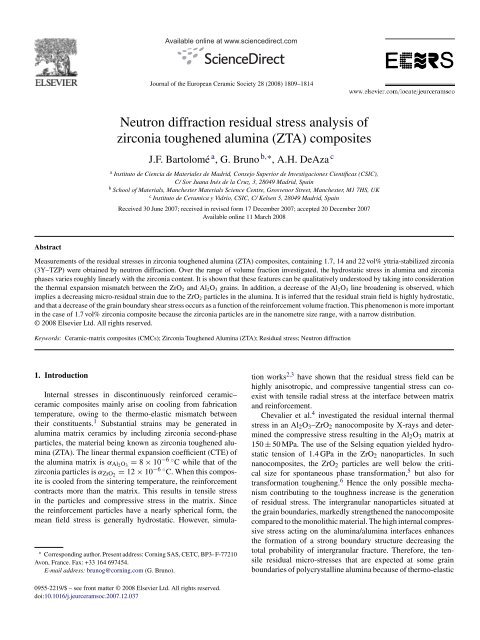

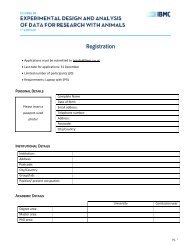

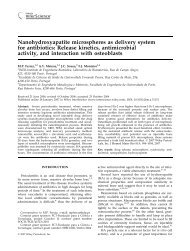
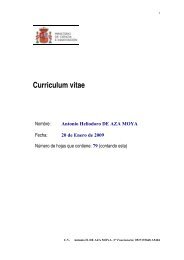
![registration form - download [pdf] - IBMC](https://img.yumpu.com/22442689/1/184x260/registration-form-download-pdf-ibmc.jpg?quality=85)
